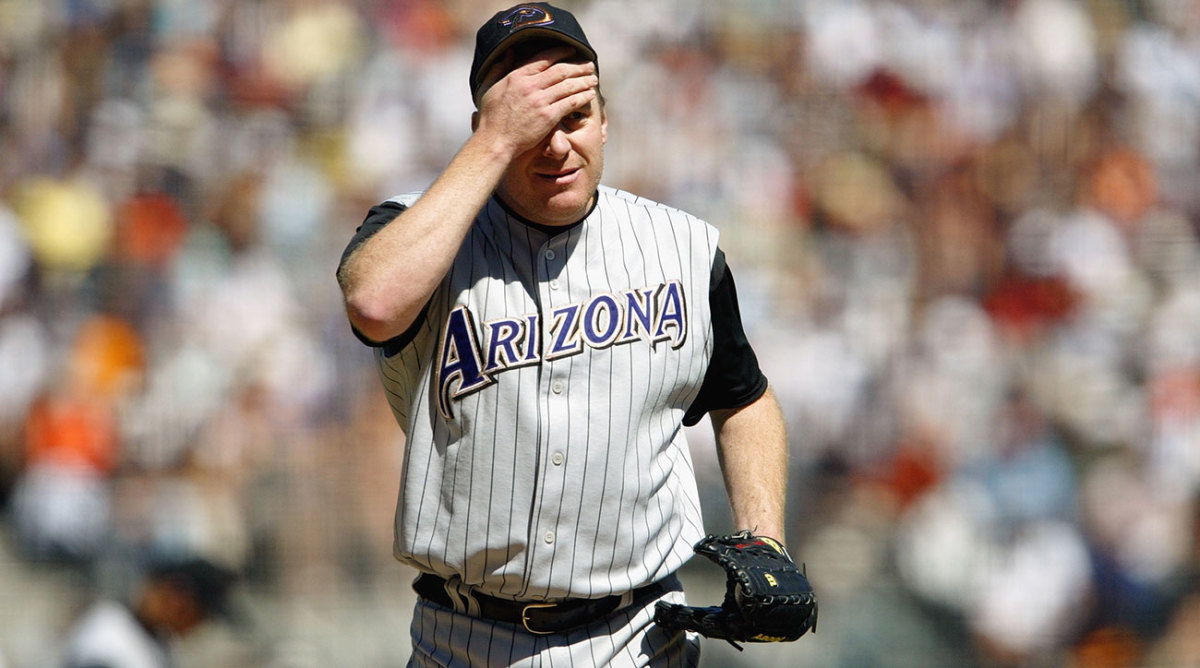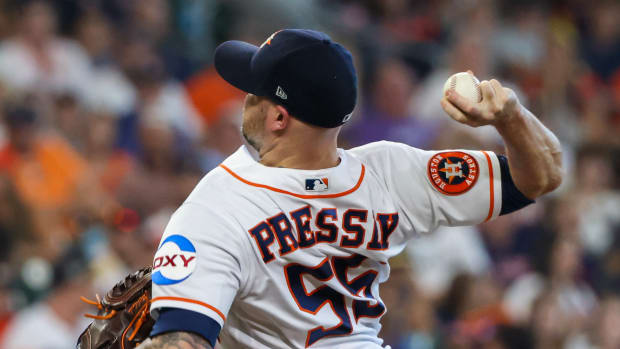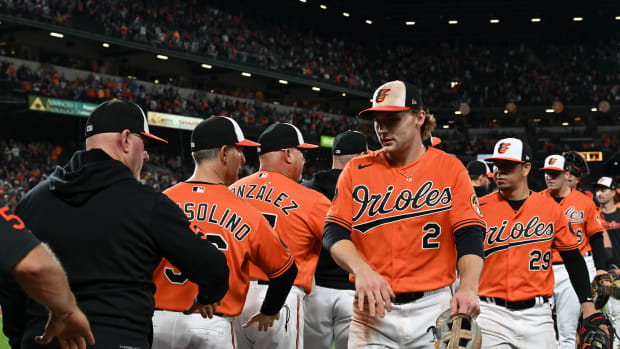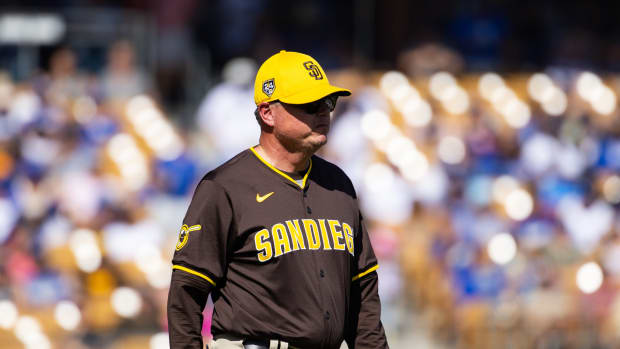
JAWS and the 2017 Hall of Fame ballot: Curt Schilling
The following article is part of my ongoing look at the candidates on the BBWAA 2017 Hall of Fame ballot. Originally written for the 2013 election, it has been updated to reflect recent voting results as well as additional research. For a detailed introduction to this year's ballot, please see here. For an introduction to JAWS, see here.
On the field, Curt Schilling was at his best when the spotlight shone the brightest. A top starter on four pennant winners and three World Series champions, he has a strong claim as the best postseason pitcher of his generation. His case for Cooperstown is backed by a track record of dominance during the regular season as well, though he never won a Cy Young award and finished with “only” 216 regular-season wins. The latter is a problem given that only three starting pitchers with fewer than 300 wins have been elected since 1992, but two of those—Pedro Martinez and John Smoltz—came in 2015, suggesting that others could follow in their wake.
Schilling was something of a late bloomer who didn't click until his age-25 season, after he had been traded three times. He spent much of his peak pitching in the shadows of even more famous (and popular) teammates, which may have helped to explain his outspokenness. Whether expounding about politics, performance-enhancing drugs, the QuesTec pitch-tracking system or a cornerstone of his legend, he wasn't shy about telling the world what he thought, earning the nickname "Red Light Curt" from former Phillies manager Jim Fregosi. But in the years since his retirement, Schilling has gone from a merely controversial and polarizing figure to one who continues to create problems for himself.
Based on the merits of his on-field performance Schilling might have sailed into Cooperstown without a fuss. But he debuted with an underwhelming 38.8% of the vote on the crowded 2013 ballot, and over the next two cycles, he took a backseat to a quintet of pitchers—Martinez, Smoltz, Tom Glavine, Greg Maddux and Randy Johnson—whose hardware and milestones led to first-ballot entries. While Schilling jumped 13% in the 2016 cycle (past the all-important 50% mark to 52.3), he has spent the months since then burning bridges with employers and voters due to his increasingly inflammatory and politicized rhetoric. He’s likely to fall back below 50% this year; the question is how much permanent damage he’s inflicted on his candidacy.
player | career | peak | jaws | w | l | era | era+ |
Curt Schilling | 79.9 | 49.0 | 64.5 | 216 | 146 | 3.46 | 127 |
Avg. HOF SP | 73.9 | 50.3 | 62.1 |
|
|
|
|
The son of a career Army man, Schilling was born in Anchorage, Alaska, in 1966 as part of a family that bounced around the U.S. before settling in Phoenix. Undrafted out of high school, he attended Yavapai Junior College in Arizona, pitched in the Junior College World Series and was chosen by the Red Sox in the second round of the now-bygone January draft in 1986. He put himself on the prospect map in 1987 by leading the Class A South Atlantic League in strikeouts at age 20, but midway through the next year, he was traded to the Orioles along with outfielder Brady Anderson in a deadline deal for pitcher Mike Boddicker. Schilling debuted in the majors in September 1988, making four starts but getting rocked for a 9.82 ERA, and he was knocked around during a similar cup-of-coffee the following year. In 1990, he stuck around Baltimore as a reliever for about half of the 1990 season, putting up a 2.54 ERA in 46 innings.
Schilling didn't exactly impress Orioles manager Frank Robinson, his first big-league skipper, with his personal appearance either. Recounted the pitcher in a 1998 Sports Illustratedprofile: "I walk in, I got the earring and half my head shaved, a blue streak dyed in it. He says, 'Sit down,' and then just cocks his head and stares at me for a while. Finally, he says, 'What's wrong with you, son?' I just sit there and act dumb and say, 'Huh? What do you mean?'"
Schilling lost the earring and the blue streak, but his lack of maturity persisted. Summoned from the bullpen in a September 1990 game, he admitted to not having paid attention to the opposing lineup. “The ‘Who’s Up?’ story spread through the organization until it became synonymous with his name. Million-dollar arm. Ten-cent head,” wrote Thomas Boswell of the Washington Post. That winter, the Orioles sent Schilling to the Astros (along with outfielder Steve Finley and pitcher Pete Harnisch) for first baseman Glenn Davis, a deal that's still reviled in Baltimore.
JAWS and the 2017 Hall of Fame ballot: Trevor Hoffman
Schilling was not a big hit in Houston, either. After spending the 1991 season in the bullpen, he was traded to Philadelphia for Jason Grimsley just before Opening Day the following year. Six weeks into the season, he finally got another shot to start and was outstanding, completing 10 of 26 turns with four shutouts. He finished the '92 season 14–11 with a 2.35 ERA in 226 1/3 innings; his ERA and 5.9 WAR both ranked fourth in the league.
Schilling's ERA ballooned to 4.02 (99 ERA+) in 1993 as a full-time member of the rotation, but his 186 strikeouts ranked fourth in the league. More importantly, he helped Philadelphia win its first division title in a decade. He then earned NLCS MVP honors against Atlanta with two strong eight-inning starts in which he allowed a combined three earned runs and struck out 19, though he received a no-decision in both. Roughed up in the World Series opener against the Blue Jays, Schilling rebounded to throw a 147-pitch, five-hit shutout in Game 5 to stave off elimination, though the Jays won the Series on Joe Carter's homer in Game 6 nonetheless.
The combination of the 1994–95 players’ strike and a trio of surgeries—for a bone spur in his elbow, torn cartilage in his left knee and, most seriously, a torn labrum and frayed rotator cuff—limited Schilling to just 56 starts from 1994 to ‘96, but he returned from his surgery with improved velocity and continued to miss bats. He whiffed 182 hitters in 183 1/3 innings in 1996, and though he made just 26 starts overall, his eight complete games led the league. Both his 3.19 ERA and his 4.9 WAR cracked the top 10.
Despite the fact that the Phillies had suffered three straight losing seasons, including a 95-loss campaign in 1996, Schilling chose to sign a below-market, three-year, $15.45 million extension in April 1997. While the hapless team went 68–94, he went 17–11 with a 2.97 ERA (143 ERA+) in 254 1/3 innings and a league-leading 319 strikeouts, the highest total in the majors since Nolan Ryan's 341 in 1977 and the most in the NL since Sandy Koufax's 382 in '65. He made his first All-Star team and placed fourth both in WAR (6.3) and in the Cy Young voting, losing out to Martinez, who struck out 305 with a 1.90 ERA for the Expos.
The next year, Schilling became the first pitcher since J.R. Richard in 1978 and '79 to notch at least 300 strikeouts in back-to-back seasons; he finished with a league-leading 300, and his 268 2/3 innings and 15 complete games—still the highest total since 1992—paced the circuit as well. His 6.2 WAR again ranked fourth.
The mileage soon caught up to Schilling. Though he earned All-Star honors for the third straight year in 1999—starting the game for the NL squad, even—he made just three starts after July 23 due to shoulder inflammation, underwent off-season surgery and didn't make another regular-season appearance until April 30, 2000. Though not as dominant as in 1997 and '98, he pitched reasonably well; with the Phillies en route to a 97-loss season, he agreed to waive his no-trade clause and was sent to Arizona for a four-player package on July 26. The Diamondbacks, tied for first place in the NL West at the time of the trade, ultimately fell short of a playoff spot.
With Schilling and lefty Randy Johnson forming the league's best one-two punch, Arizona won the division in 2001. Schilling set career highs with 22 wins and 8.8 WAR and struck out 293 hitters in 256 2/3 innings, walking just 37 for an eye-popping 7.5 strikeout-to-walk ratio. He would have waltzed home with the Cy Young award had Johnson not struck out 372 and won 21 games himself en route to the second of four straight Cy wins; Schilling placed second in the vote.
Schilling built on that dominant regular season by sparkling in the playoffs. In the first two rounds against the Cardinals and the Braves, respectively, he threw three complete-game victories and struck out 30, allowing just three runs. In the World Series against a Yankees team seeking its fourth straight championship, he yielded one run in seven innings in a Game 1 win, then duplicated that performance on three days' rest in Game 4. He was in position to get the win in that game too, until Diamondbacks closer Byung-hyun Kim allowed a game-tying, two-run homer to Tino Martinez in the ninth and then Derek Jeter’s walk-off solo shot in the 10th.
The Series wound up stretching to seven games, where Schilling again took the ball on three days' rest. He held the Yankees scoreless for the first six innings but departed in the eighth, trailing 2–1 after surrendering a homer to Alfonso Soriano. Johnson came out of the bullpen in relief, and Arizona rallied for two runs in the bottom of the ninth inning against Mariano Rivera to win the title. Schilling shared co-MVP honors with Johnson (and soon enough, Sports Illustrated’s Sportsmen of the Year honors as well). For the postseason, he had put up a 1.12 ERA, setting records for innings (48 1/3 innings, surpassed by Madison Bumgarner in 2014), and strikeouts (56) and walking just six.
JAWS and the 2017 Hall of Fame ballot: Tim Raines
Schilling placed second to Johnson in the Cy Young voting again the following year, an 8.7 WAR campaign in which he won 23 games, struck out 316 batters and walked just 33 for a 9.6 strikeout-to-walk ratio; he led the league in that latter category for the second straight season and would go on to do so five times in a six-year span from 2001 to '06. After a 2003 season in which he was limited to 24 starts by an appendicitis and two fractured metacarpals (via a pair of comeback shots in the same game), he waived his no-trade clause for a deal to the Red Sox. As part of the trade, Schilling signed a three-year, $37.5 million extension with a $13 million vesting option contingent on the Red Sox winning the World Series, something that hadn't happened since 1918 (the clause actually ran afoul of MLB’s contract rules).
Pairing with Martinez as Boston's co-ace, Schilling put up another banner season, with 21 wins, a 3.26 ERA (148 ERA+ in hitter-friendly Fenway Park) and 203 strikeouts. He earned All-Star honors for the sixth time, but a tendon problem in his right ankle hampered him as the postseason came around. Following an unexceptional Division Series start against the Angels, he was chased by the Yankees after just three innings in Game 1 of the ALCS. It didn't appear as though the injury would matter once New York built a 3–0 series lead, but when the Sox clawed their way back, Schilling took the ball for Game 6 in the Bronx.
The day before the start, doctors performed an experimental procedure to secure a tendon in place using three stitches; TV shots that night routinely captured the blood in Schilling's ankle seeping through his sock. Nevertheless, his body held together long enough for him to turn in a seven-inning, one-run performance, helping the Sox force a Game 7, which Boston won handily. He threw six innings of one-run ball against the Cardinals in Game 2 of the World Series, helping Boston to its first world championship in 86 years.
Despite off-season surgery, Schilling's ankle continued to trouble him well into the following year. Splitting his time between the rotation and closing—something he'd done regularly only in early 1991—he finished with an ugly 5.69 ERA in just 93 1/3 innings. He rebounded to throw 204 innings of 3.97 ERA (120 ERA+) ball in 2006, striking out 183 and finishing with a stellar 6.5 strikeout-to-walk ratio, but the Red Sox missed the playoffs. Following a strong start in 2007, his season unraveled after he fell one out shy of no-hitting the A’s on June 7, as he lost six weeks to shoulder inflammation. Schilling struggled before mustering some semblance of his old form in the postseason: He threw seven shutout innings in the Division Series clincher against the Angels, rebounded from an ALCS Game 2 pounding by the Indians to yield two runs over seven innings in Game 6 and wobbled through 5 1/3 innings in Game 2 of the World Series against the Rockies—another sweep, as it turned out.
Schilling signed an incentive-laden one-year, $8 million deal to return to Boston in 2008, but further shoulder problems that winter led to a public battle with the team over his treatment. He didn't undergo surgery to repair his biceps tendon and labrum until June, and he never made it into a game. The following spring, he announced his retirement.
Schilling finished with 216 wins, a lower total than all but 16 of the 62 starting pitchers in the Hall of Fame, only three of whom (Koufax, Smoltz and Don Drysdale) pitched in the majors during the post-1960 expansion era. The BBWAA voters have taken a long time to accept the idea that pitcher wins aren't the ideal measure of success in a modern era where it's been shown that offensive, defensive and bullpen support are major factors in the compilation of those precious Ws. After electing Fergie Jenkins (284 career wins and seven 20-win seasons) in 1991, it took until Bert Blylelven (287 wins) in 2011—for another starter with fewer than 300 victories to be elected by the writers. Given that it took the writers 14 years to elect Blyleven, that Jack Morris (254) was nearly elected before falling off the ballot in 2014 and that Smoltz gained entry armed with a Cy Young award and additional credentials as a dominant closer, it’s still not clear that a majority of voters has let go of win totals.
JAWS and the 2017 Hall of Fame ballot: Jeff Bagwell
Schilling was the first among a wave of non-300 win pitchers to hit the ballot, followed by Mike Mussina (270 wins) in 2014 and Martinez (219) and Smoltz (213) in '15. Pitching in the highest scoring era since the 1930s, those men more than held their own against lineups much deeper than their predecessors faced, working deep into counts to rack up high strikeout totals before yielding to increasingly specialized bullpens. The shape of their accomplishments may be different than the even larger cohort of pitchers from the 1960s and '70s who helped set that 300-or-bust standard, but they belong alongside them in Cooperstown just the same. Martinez and Smoltz went in without a fuss, which should open the door for Schilling and Mussina, with future candidates such as Roy Halladay (203 wins) possibly benefiting as well.
Even so, Schilling's candidacy has far more than wins going for it. He was 11–2 with a 2.23 ERA in 133 1/3 postseason innings covering 19 starts, helping his teams to four pennants and three championships; in the World Series alone, he was 4–1 with a 2.06 ERA in seven starts totaling 48 innings. Other pitchers of his era racked up more appearances and wins, but no starter from the post-1960 expansion era with at least 100 postseason innings had as low an ERA. Among pitchers from that era with at least 40 innings in the World Series, only Koufax (0.94) and Bob Gibson (1.89) have lower ERAs from lower-scoring eras, making Schilling's accomplishments all the more impressive.
Turning back to the regular season: Schilling's 3,116 strikeouts rank 15th all-time, and his 8.6 strikeout-per-nine rate ranks third among pitchers with at least 3,000 innings, behind only Johnson and Ryan and just ahead of Roger Clemens. It's true that Schilling pitched in an era where strikeout rates were almost continually on the rise, but he was still ahead of the curve: His trio of 300-K seasons puts him in the company of Johnson, Ryan and Koufax as the only pitchers with more than two such seasons during the expansion era, and he finished in his league's top five in strikeouts eight times. What's more, he demonstrated impeccable control while doing so, leading the league in strikeout-to-walk ratio five times and placing in the top five another four times; his 4.4 ratio is the highest of any post-19th century pitcher.
Schilling never won a Cy Young award, but he placed second three times from 2001 to '04. Because he's all over the leaderboard in key pitching categories, he scores very well in Bill James' Hall of Fame Monitor metric, which gives credit for awards, league leads, postseason performance and so on; on a scale where 100 indicates "a good possibility" of making the Hall of Fame and 130 indicates "a virtual cinch," his 171 points clear the bar by a mile.
Schilling's ability to miss bats and prevent runs led to eight top five finishes in WAR and nine seasons of at least 5.0 WAR; among his contemporaries, only Clemens (14), Johnson (11), Maddux (11) and Mussina (10) had more, while Martinez had as many. His 79.9 career WAR ranks 26th all-time, six wins above the standard for Hall of Fame starters. His peak score of 49.0 WAR is 1.3 wins below the standard—a couple runs per year, spread out over seven seasons. His overall JAWS, however, is 2.4 ahead of the standard, good for 27th all-time, ahead of five 300-game winners (Glavine, Ryan, Mickey Welch, Don Sutton and Early Wynn) as well as 32 other enshrined starters. That's a Hall of Fame pitcher.
After debuting with 38.8% of the vote in 2013, Schilling lost and then regained around nine points over the next two cycles before climbing to 52.3% in ‘16. The 50% threshold is significant, as he joins Gil Hodges, Jack Morris and current candidates Jeff Bagwell and Lee Smith as the only candidates to receive that much support and never gain entry—and the books are hardly closed on any of them. Bagwell is poised for election this year, Morris and Smith will have their days in front of the Era committees, and Hodges—most recently a candidate on the 2014 Golden Era ballot—is sure to resurface again.
Still, Schilling’s trajectory is unclear. Of the eight other candidates to receive between 45% and 60% in their fourth year, Smith, Clemens and Bagwell aren’t in yet, and only the last of them is close. Of the other five, Jim Bunning needed the Veterans Committee, and Drysdale, Andre Dawson, Tony Perez and Hoyt Wilhelm took an average of five more years to get to 75%.
It’s safe to say that none of those four worked as hard to damage their candidacies en route to Cooperstown. Schilling, on the other hand, has spent the last year and a half alienating anyone who doesn’t share his political beliefs, which have been a significant part of his public persona going back to when he stumped for George W. Bush on Good Morning America just hours after the Red Sox won the 2004 World Series. That was an unpopular move in a state that voted heavily for Massachusetts senator John Kerry during that year's presidential election.
Schilling hasn’t helped matters since by trafficking in increasingly offensive statements. In August 2015, he was suspended by ESPN from covering the Little League World Series after posting a Twitter meme that compared Muslim extremists to German Nazis. He deleted the tweet and apologized but continued to post anti-Muslim and anti-illegal immigrant memes on Facebook. After an exchange with the media blog Awful Announcing that caught the network off guard, Schilling was suspended by ESPN through the remainder of the 2015 season.
Despite making the aforementioned significant gain from the 2015 to ‘16 cycles, Schilling claimed that his political views were costing him votes. In March 2016, he told a radio station that Hilary Clinton “should be buried under a jail somewhere,” a violation of an ESPN policy on commenting on the presidential election. In April, after he shared another offensive Facebook meme about transgender bathroom laws, the network fired him, saying in a statement, “ESPN is an inclusive company. Curt Schilling has been advised that his conduct was unacceptable and his employment with ESPN has been terminated.”
In October, Schilling began hosting an online radio show on Breitbart, a far-right website that the Southern Poverty Law Center has called a “white ethno-nationalist propaganda mill.” In November on Twitter, Schilling praised a pro-Trump t-shirt advocating the lynching of journalists; “So much awesome here,” he said of a shirt that read, “Rope. Tree. Journalist. Some assembly required.”
With that, several BBWAA voters—including past presidents Susan Slusser and Jose de Jesus Ortiz as well as Jon Heyman and Dan Shaughnessy (both of whom had publicly feuded with Schilling during his career but subsequently included him on their Hall ballots)—proclaimed that they were withdrawing their support of Schilling’s candidacy at least for 2017, citing the same character clause that many voters use to justify not voting for players connected to PED use. In those voters’ eyes, Schilling had moved beyond politics to condoning violence. Wrote Slusser, “I've voted for him previously. But seems to me like advocating murder goes against character clause.” Wrote Ortiz, “[P]roposing lynching pretty much sinks his chance on my ballot on character clause.” Wrote Shauhgnessy, last year’s recipient of the Hall’s Spink Award: “[Schilling] has transitioned from a mere nuisance to an actual menace to society.” Said Heyman in a radio interview, “There is a line there to me and he crossed that line by espousing lynching.”
While I’m not a huge fan of the character clause when it’s invoked against PED-tainted candidates given the rogue’s gallery that’s already within the Hall, I agree with those writers that Schilling has crossed a line. Even within the context of the 2016 presidential campaign’s charged rhetoric, his words were beyond the pale, and his weak claim of “sarcasm” doesn’t hold water, as he showed no remorse for setting off yet another firestorm.
I’m not saying I would never support his candidacy again; if I were, I wouldn't have updated this profile full of objective arguments in his favor. But even on my virtual ballot (I’m not eligible for a real one for another four years), I can’t in good conscience advocate the celebration of anyone with such a corrosive public persona in any context, nor can I blame any voter for taking a similar stance, particularly at a time when a reasonable voter might agonize about winnowing a ballot down to 10 candidates.
The JAWS project has always been about elevating or at least maintaining the standards of the Hall, and its critics have suggested that there should be more to a player’s case than just numbers, there’s a human element. Well, here you go. I never thought I’d explicitly have to state that basic human decency should be part of the Hall standard, but at this moment, to these eyes, I’m convinced that Schilling is short of it.




































